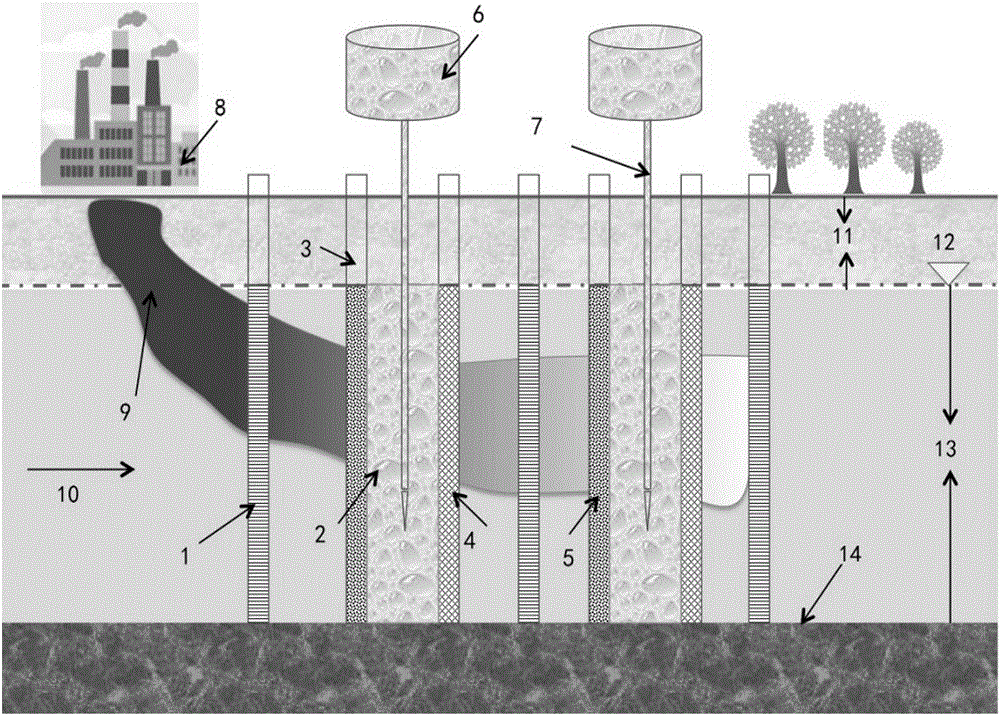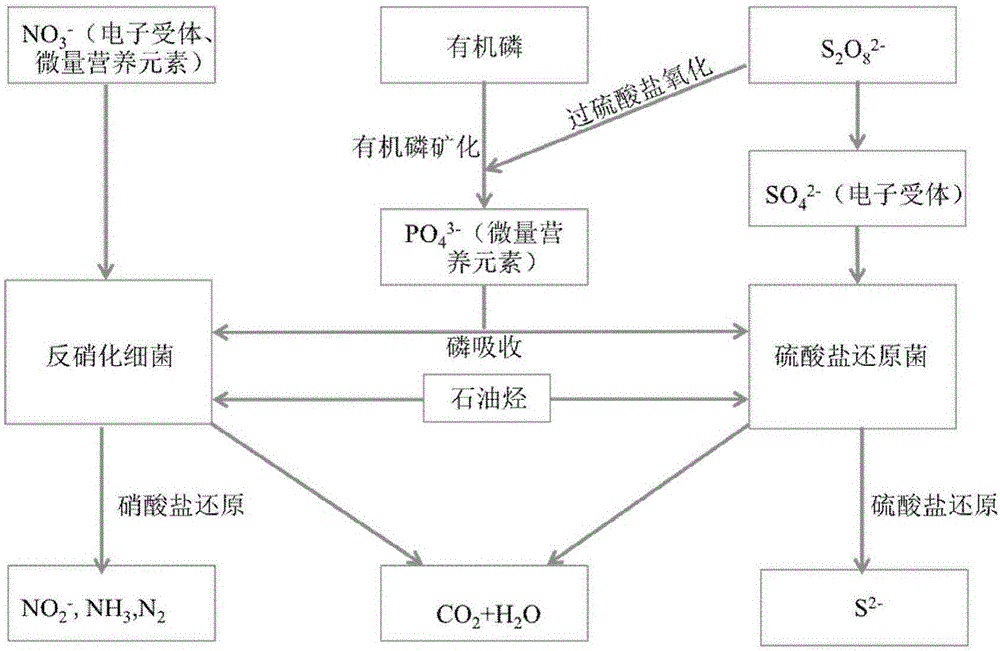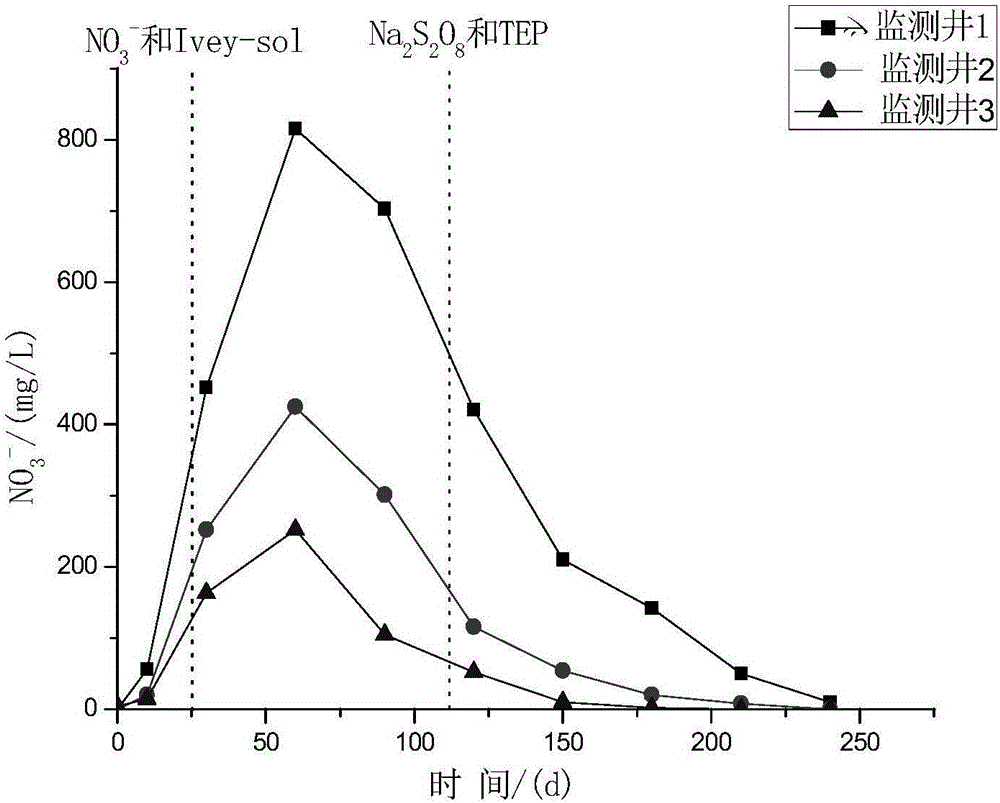Permeable reactive barrier system and method for in-situ remediation of petroleum hydrocarbon in groundwater by enhanced anaerobic biotechnology
A technology of osmotic reaction wall and biotechnology, applied in the field of groundwater in-situ remediation, can solve the problems of low solubility of petroleum hydrocarbons, high treatment cost, limited application, etc., to increase hydraulic retention time, accelerate anaerobic degradation efficiency and treatment cost. reduced effect
- Summary
- Abstract
- Description
- Claims
- Application Information
AI Technical Summary
Problems solved by technology
Method used
Image
Examples
Embodiment 1
[0048] The geological analysis of the implementation area shows that it is composed of sand and clay at about 1.2 meters from the surface to the ground, and low-plastic silty clay at 3 meters underground.
[0049] like figure 1 As shown, the groundwater level 12 fluctuates at approximately 3.1 meters below the ground, and the direction of groundwater flow 10 is as follows figure 1 As shown in the vadose zone 11, monitoring found that the main organic pollutants in the groundwater of the site are petroleum pollutants. In the aquifer 13, there is a petroleum hydrocarbon with a length of about 200 meters, a width of about 130 meters, and a thickness of about 5.9 meters. Pollution plume. Construction of an osmotic reaction wall system for in-situ remediation of petroleum hydrocarbon-contaminated groundwater using enhanced anaerobic biotechnology, including monitoring well 1, well pipe 3 filled with sand 5, baffle 4, water barrier 14 and injection well 2, injection well The wel...
Embodiment 2
[0061] Geological analysis of the implementation area shows that it is composed of sand, gravel and clay from the surface to about 1 meter underground, and is composed of weathered rock at 2.5 meters underground. The groundwater level fluctuates about 2.8 meters below the ground.
[0062] Monitoring found that the main organic pollutant in the groundwater of the site was benzene, and there was a benzene pollution plume about 60 meters long, 40 meters wide and 4 meters thick in the aquifer. Construction of an in-situ osmotic reaction wall system utilizing enhanced anaerobic biotechnology to remediate petroleum hydrocarbon-contaminated groundwater, including monitoring well 1, well pipe 3 filled with sand 5, baffle 4, aquifer 14 and injection well 2; The osmotic reaction wall system is provided with a groove downstream of the groundwater pollution plume 9 and perpendicular to the direction 10 of groundwater flow, the well pipe 3 filled with sand 5 is placed in the groove, and a ...
Embodiment 3
[0074] The geological analysis of the implementation area shows that the geological analysis of the implementation area shows that it is composed of gravel, fine-medium sand and clay at about 1.5 meters from the surface to the ground, and is composed of silt and fine sand at 3.2 meters below the ground. The groundwater level fluctuates about 3.5 meters below the ground.
[0075] Monitoring found that the main organic pollutants in the groundwater of the site were benzene and toluene, and there was a benzene and toluene pollution plume about 160 meters long, 100 meters wide and 5.2 meters thick in the aquifer. Construction of an in-situ osmotic reaction wall system utilizing enhanced anaerobic biotechnology to remediate petroleum hydrocarbon-contaminated groundwater, including monitoring well 1, well pipe 3 filled with sand 5, baffle 4, aquifer 14 and injection well 2; The osmotic reaction wall system is provided with a groove downstream of the groundwater pollution plume 9 and...
PUM
| Property | Measurement | Unit |
|---|---|---|
| particle diameter | aaaaa | aaaaa |
| height | aaaaa | aaaaa |
| particle diameter | aaaaa | aaaaa |
Abstract
Description
Claims
Application Information
 Login to View More
Login to View More - R&D
- Intellectual Property
- Life Sciences
- Materials
- Tech Scout
- Unparalleled Data Quality
- Higher Quality Content
- 60% Fewer Hallucinations
Browse by: Latest US Patents, China's latest patents, Technical Efficacy Thesaurus, Application Domain, Technology Topic, Popular Technical Reports.
© 2025 PatSnap. All rights reserved.Legal|Privacy policy|Modern Slavery Act Transparency Statement|Sitemap|About US| Contact US: help@patsnap.com



